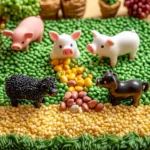Creating a farm sensory bin is a delightful and interactive way to engage children’s senses while fostering imaginative play. This hands-on activity allows little ones to explore textures, colors, and sounds in a fun-filled environment. It’s perfect for rainy days, playdates, or as an educational tool to teach kids about farming, animals, and nature. With a variety of safe and simple materials, you can set up this sensory bin in no time, offering endless opportunities for play and learning. Whether you choose to use real natural materials or opt for craft items, the farm sensory bin promises to spark curiosity and creativity in every child.
Why You’ll Love This Farm Sensory Bin:
- Engaging Play: Encourages imaginative play as children create their own farm scenarios.
- Sensory Exploration: Offers a variety of textures, colors, and sounds for tactile learning.
- Educational Value: Teaches kids about farm life, animals, and nature.
- Easy to Set Up: Simple materials that can be quickly gathered.
- Customizable: Lots of options to personalize the bin to suit different interests.
- Ideal for All Ages: Fun for toddlers to preschoolers and beyond.
Materials:
- Large plastic bin or container
- Shredded green paper or fabric for grass
- Small toy farm animals (cows, horses, chickens, etc.)
- Toy tractors or farm vehicles
- Real or artificial hay
- Plastic fruits and vegetables (optional)
- Measuring cups and scoops
- Small shovels or gardening tools
Full Step-by-Step:
1. Prepare the Bin
- Choose a large plastic bin or container to contain the materials.
- Layer the bottom of the bin with shredded green paper or fabric to simulate grass.
2. Add Hay and Animals
- Scatter some real or artificial hay in the bin for texture and appearance.
- Place the small toy farm animals throughout the bin, positioning them in “habitats.”
3. Incorporate Farm Vehicles
- Add toy tractors or other vehicles to encourage imaginative play.
- Let children arrange the vehicles around the animals and ask them to move them around the bin.
4. Include Fruits and Vegetables
- If desired, add some plastic fruits and vegetables to teach about produce found on farms.
- Use measuring cups and scoops for pouring and sorting activities.
5. Encourage Play
- Invite children to use their hands and tools to dig, bury items, and create their own farm scenarios.
- Discuss the different animals and crops as they play to enhance learning.
Tips & Variations:
- Customize Textures: Experiment with different textures by adding rice, beans, or sand instead of shredded paper.
- Switch Up the Theme: Create a garden sensory bin with flowers and gardening tools instead of a farm.
- Seasonal Changes: Update the bin with seasonal items, like pumpkins in the fall or flowers in the spring.
- Scented Additions: Incorporate scents with items like lavender or mint to enhance the sensory experience.
Frequently Asked Questions:
Q1: What age group is this sensory bin suitable for?
A: It’s ideal for toddlers and preschoolers, but older children can also enjoy the activity with added complexity.
Q2: Can I use real hay?
A: Yes, real hay can be used; however, ensure no allergies are involved. You can substitute with artificial or paper options if necessary.
Q3: How do I clean up after play?
A: Use a broom and dustpan to collect any loose materials. Store reusable items in a container for future play.
Q4: What if I don’t have all the materials?
A: You can easily swap out materials with household items, like using buttons for vegetables or small blocks for animals.
Suggestions:
- Consider pairing the sensory bin with storybooks about farms to enhance learning and engagement.
- Add a simple craft activity, like making animal masks, to extend the play experience.
- Organize a playdate where children can share their own ideas for farm scenarios.
Final Thoughts
Creating a farm sensory bin is not only educational but also a wonderful way to spark creativity and foster sensory exploration in young children. We hope you and your little ones enjoy this engaging activity! Feel free to share your own versions of the farm sensory bin or leave a comment on your experience. Happy playing!
Print
Farm Sensory Bin
- Total Time: 10 minutes
- Yield: Multiple play sessions
- Diet: N/A
Description
A fun and engaging sensory bin activity that allows children to explore textures, colors, and sounds while learning about farming.
Ingredients
- Large plastic bin or container
- Shredded green paper or fabric for grass
- Small toy farm animals (cows, horses, chickens, etc.)
- Toy tractors or farm vehicles
- Real or artificial hay
- Plastic fruits and vegetables (optional)
- Measuring cups and scoops
- Small shovels or gardening tools
Instructions
- Prepare the Bin: Choose a large plastic bin and layer it with shredded green paper to simulate grass.
- Add Hay and Animals: Scatter hay in the bin and place toy farm animals throughout.
- Incorporate Farm Vehicles: Add toy tractors and let children arrange them around the animals.
- Include Fruits and Vegetables: Add plastic fruits and vegetables and use measuring cups for sorting activities.
- Encourage Play: Invite children to dig and create farm scenarios while discussing the animals and crops.
Notes
Customize textures with different materials and update the theme seasonally. Pair with storybooks for enhanced learning.
- Prep Time: 10 minutes
- Cook Time: 0 minutes
- Category: Activity
- Method: Sensory Play
- Cuisine: N/A
Nutrition
- Serving Size: Multiple children
- Calories: N/A
- Sugar: 0g
- Sodium: 0mg
- Fat: 0g
- Saturated Fat: 0g
- Unsaturated Fat: 0g
- Trans Fat: 0g
- Carbohydrates: 0g
- Fiber: 0g
- Protein: 0g
- Cholesterol: 0mg

